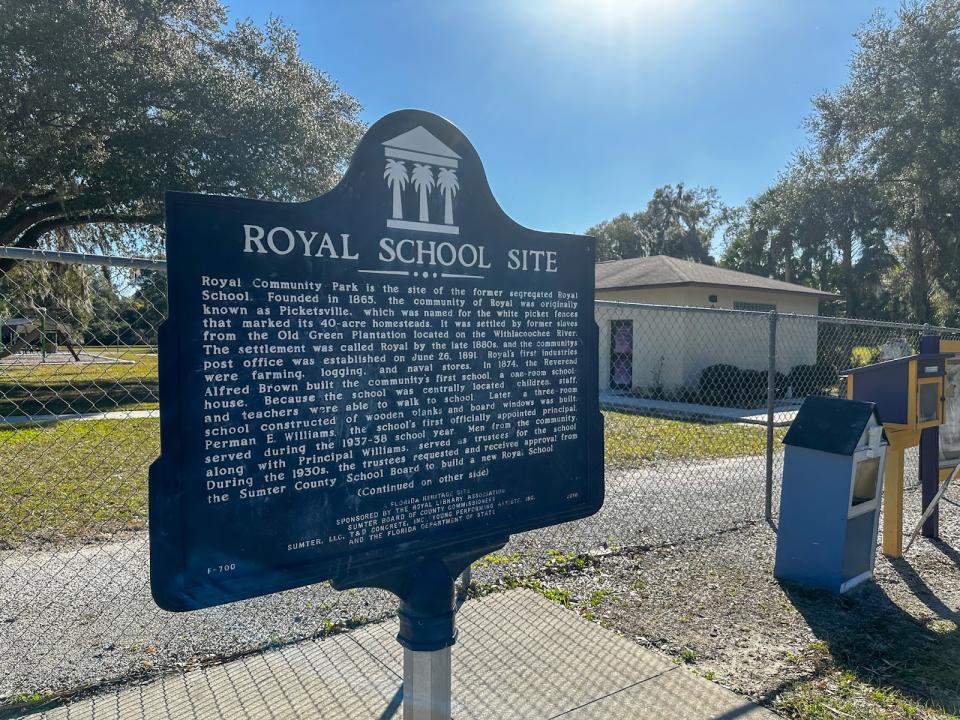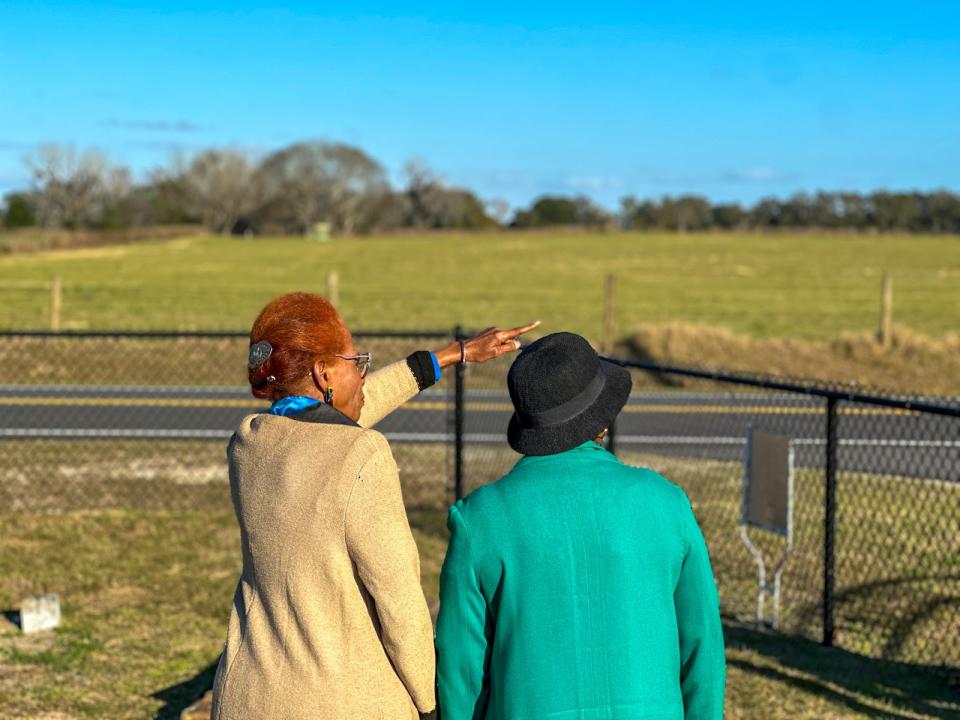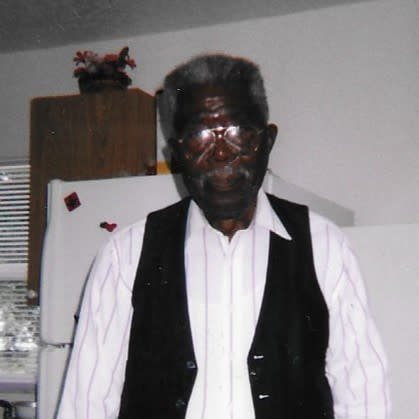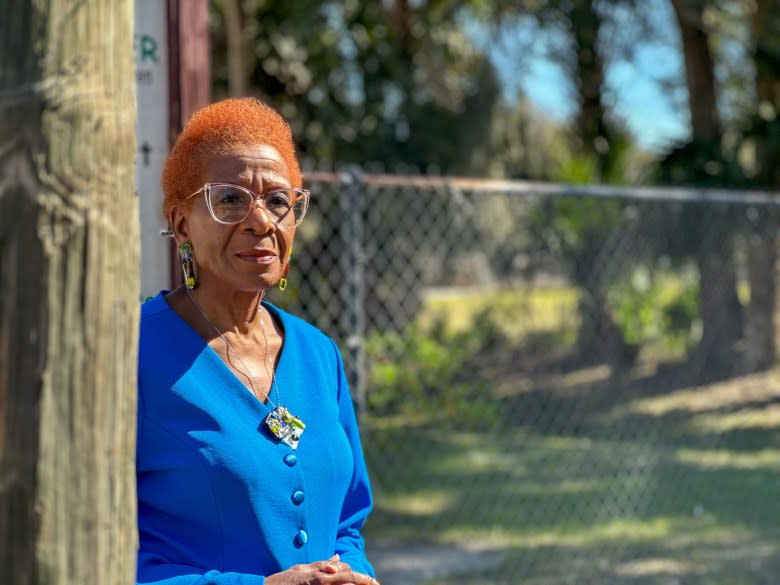The Fight to Protect One of America’s Last Historic Black Communities
ROYAL, Florida — The calmness of the wind reverberated across the burial ground as Beverly Steele motioned to her mother’s grave in Oak Hill Cemetery. Three months ago, they buried her here, just 12 days shy of her 102nd birthday.
It’s not uncommon for residents in the majority-Black, unincorporated community of Royal, Florida, to live past 100 years old. The Rev. Matthew Beard, the oldest resident in the community’s history, lived to be 115.
On a recent February afternoon, Steele, dressed in her Sunday best, peered out at the acres and acres of land surrounding Oak Hill Cemetery, also known as the Royal Cemetery. As she reminisces about her mother, she also remembered her aunt, who was called on as the community’s local historian. She could recall who had the first brick house, the first postmaster, and the three founding families — Hollies, Picketts, and Andersons — of the community.
The sounds of large trucks chugging down the narrow road near the cemetery snap Steele back to today’s reality. Mere miles away from the site is Interstate 75, which split the community of Royal in half 50 years ago. A few miles from there is the old Monarch Road cemetery, or old slave cemetery as the locals call it. It, too, is split in half by a paved road. A family lives on the primary site where most of the headstones can be seen. It is the cemetery where Steele’s great-great-great-grandfather — and one of the community’s co-founders — is buried.
Tucked away, 55 miles north of Orlando, Royal’s estimated 1,200 Black residents still live on the inherited 40-acre plots from the Homestead Act of 1862. The close-knit community is located in the city of Wildwood, which in the past two decades has grown in population to 150,000. The 77-year-old Steele and other Royal residents say the rapid growth of The Villages, a retirement community that borders Wildwood, is part of the constant development efforts upending their lives.
Recent plans for highways, affordable housing units, and industrial use projects are disrupting their peace and comfort. In some cases, residents have been pressured to sell their land. Several community members raised concerns to Capital B that these attacks are attempts to erase its history and gentrify its neighborhoods. They also fear the increased traffic and industrial pollution from the projects will cause detrimental health effects in its community of mostly elders.
Steele is also fighting for Royal to get national recognition. Beyond its unique, rural and historical landscape, it is one of the few surviving historic communities, despite the history of Black towns being destroyed or violently displaced. Royal is one of two remaining Black homesteading communities left in the nation. The other is Nicodemus, Kansas. The Homestead Act allowed citizens to own land given by the U.S. government after five years of living on and improving it. The historic preservation and continued existence of Royal is even more paramount in a state like Florida, where the NAACP issued a travel advisory for Black folks in lieu of the laws banning Black history courses and dismantling diversity, equity, and inclusion efforts.
Read more: A Florida Community Faces Erasure. Residents Are Honoring Its History.
Steele’s battle is arduous, but too important to give up. New homeowners in the Highland Hills complex will live directly across the street from Oak Hill, where Steele’s mother was laid to rest. She also fears Royal residents will eventually be displaced.

Through her nonprofit, Young Performing Artists Inc., Steele began sharing the community’s history with youth more than 25 years ago. In turn, the kids shared the history with their parents and grandparents.
“People knew that they had land passed down, but they didn’t have any idea of how we got the land, why the 40 acres, and the significance of Royal and African Americans being able to get the land at the time that they did,” the local historian told Capital B. “It’s tremendous to us because they were able to take the message even further than we were.”
This history led Steele on a decades-long pursuit to get the history documented, verified, and listed on the National Park Services’ National Register of Historic Places. It’s been no small feat. After submitting its application for nomination, Steele says state officials redrew the community’s boundaries to exclude historically Black properties. White landowners also objected: they didn’t want their properties included in the listing. Last fall, Steele secured legal help and guidance from the Southern Poverty Law Center.
Being listed on the National Register won’t stop developers from encroaching on their community. Their hope, though, is that the historic designation will protect its boundaries and lead to more restrictions that make it harder for development that isn’t culturally or historically appropriate, they say.
“Land is an asset, and we want our generations to be able to benefit from that,” Steele said. “The threats we’re facing, what’s so empowering about it is that everyone supports Royal being recognized, but they want to diminish the boundaries … diminish the value of this land and our intergenerational wealth that we have gained.”
Steele said the locals aren’t afraid of development, but they want development that’s more characteristic of the historic community, and they want county officials to start recognizing the community’s historic value.
“For seven generations now, land in Royal has passed from one generation to the next in spite of centuries of racial violence and economic displacement. Today, land can be used as a powerful tool for growing generational wealth but can just as easily be used to strip communities of their wealth,” said Malissa Williams, senior attorney for the Southern Poverty Law Center.
Surrounded by development



This isn’t the first time Royal citizens have come up against efforts to build in their community.
Residents, along with Sumter County commissioners, rejected a plan in 1988 to construct a turnpike through Royal. In 2019, state lawmakers approved a bill to construct the Northern Florida Extension, or turnpike project, to build three roads across rural central Florida, including Royal.
Although the bill was repealed, it was given new life in 2022. Community outrage led the Florida Department of Transportation to halt the extension project, which would’ve destroyed homes, a community center, and two churches in Royal.
A spokesperson from the Florida Department of Transportation wrote in an email statement to Capital B that the agency is focused on improving I-75 instead of the turnpike extension. It’s a direct result of the meaningful engagement from communities, including Royal.
“[In November], FDOT District Five Secretary John Tyler and other representatives with the Department met with interested residents and community leaders of Royal to discuss the proposed I-75 improvements, plans for the County Road 462 bridge, and retention pond locations,” the statement said. “We will continue to keep Royal and other surrounding communities engaged and informed as the project progresses.”
That win for the community was short-lived. After that, the county commissioners amended its comprehensive plan and approved rezoning requests for developers, despite fierce opposition from residents. Royal isn’t even included in the county’s comprehensive plan, which is a guide for growth and development for their jurisdictions.
In front of the entrance of the Oak Hill burial site will be Highland Homes Family Housing, a 532-home development on less than 200 acres, which goes along County Road 229 and State Road 44. The area borders a 400-acre farm owned by David Cuthers, who also spoke out against it, according to the local Villages News.

On the other side of the cemetery, where Steele and other Black families have lived since the founding of Royal in 1865, sits 60 acres owned by Werner Enterprises Inc., which wants to develop a truck stop near I-75 and State Road 44. The development is expected to generate an estimated 5,000 daily trips, which concerns some residents. The rezoning request for this project included nine requirements, including setbacks from adjacent property and restrictions on noise and truck idling. Commissioners also approved 8G Farm Inc.’s request to rezone 136 acres along County Road 475 for industrial development. Steele and Nathaniel Williams, a fellow Royal resident, challenged it, but were unsuccessful.
Some companies have even approached residents like 90-year-old Maitland Keiler and 98-year-old Annie Johnson to sell their land. Each letter is thrown into the garbage can because the land “is not for sale,” they told Capital B.
Keiler, along with his nieces and nephews, still lives on land his family inherited. They had a total of 80 acres, but have only 56 acres today. Some of the land was used to build I-75 and his family didn’t receive a fair price, he said.
“[The interstate] is right across the edge of my relatives’ land. And you know what? They just took that from us mostly. There were two prices. One for the Black one and one for white one,” Keiler said. “[One of the white owners] told my uncles before they died how much money they got [from the state] for their land. It was much more than what they gave us.”


Johnson believes that because Royal is an unincorporated, Black and older community, it makes them more vulnerable to such threats. Because they don’t have direct representation, their concerns go unheard.
A few months ago, her home mailbox got destroyed. Since Royal no longer has a post office, she now has to travel to Wildwood to get her mail, which is difficult because she doesn’t have transportation.
“They bleed the same blood that I bleed. They eat the same things I eat. They have to live on and live like me, and just because of the color of our skin, why are we different?” Johnson asked.
Royal residents won’t back down
One of the biggest battles of contention stem from getting national recognition for Royal, which has been in the works long before the heightened development threats. In 2016, Steele hired Edward González-Tennant, historian and digital archaeologist, to conduct a Cultural Resources Assessment Survey, or CRAS, to document the historical resources in the community.
Aside from documentation, this allowed González-Tennant to solidify Royal as a local, state, and national treasure, he said, especially with the demise of similar communities in Florida.
He pointed to Rosewood, which was a thriving Black community less than 100 miles from Royal, until a racist and violent mob of white men destroyed the town and forced residents out in 1923. Steele believes the fate for Rosewood could have been the same for Royal, if it weren’t for Jesse Woods.

In 1956, Woods, a Black farmer from Royal, was arrested for allegedly saying “Hello there, baby” to a white school teacher in Wildwood. Wood was thrown in jail, kidnapped, and almost beaten to death by a group of white Ku Klux Klan members. With the help from the NAACP, a trial was held. During the trial, Woods refused to identify the men who tortured him. Steele believes this is what saved Royal from being “another Rosewood,” she said.
“These are places that faced violence and for little more than just existing as places where African Americans could pursue the American dream of having jobs and owning property and sending their kids to school and so forth,” González-Tennant said. “[Places like Rosewood] never had that opportunity to see what intergenerational wealth might be like for its descendants a century later. With Royal, you have a Black community that can sort of explore those things.”
He prepared an application and submitted it to the state’s historic preservation officer, the first step in the process. The proposal included 3,500 acres of land, but after white property owners contested the decision, they revised the boundaries to 2,500 acres. The state historic preservation officer redrew the boundaries to 1,945 acres, which Steele and González-Tennant say excluded about 24 Black families who have had land for generations.
One of those people: Mother Lily Soloman who was the first lady of the local Baptist church and second midwife in the community, Steele said.
The state went forward and sent their nomination to the Keeper of the National Register of Historic Places. Last summer, the SPLC and González-Tennant sent separate petitions to the keeper to conduct a review and reconsider Royal’s national significance.
The keeper agreed in a recent opinion that the Royal community district met the criteria to be listed on the registry. It returned the nomination and asked the state to better document its boundaries and make technical edits to the nomination.

A spokesperson for the state denied the agency changed any boundaries. In an email statement to Capital B, the spokesperson confirmed that the revisions have been made and resubmitted for a final determination by the National Park Service. If the National Park Service approves the nomination, Royal would become the park service’s first rural district in Florida.
In the meantime, Steele and other community organizers are petitioning Sumter County officials to get Royal added in its comprehensive plan. They are also looking for other ways to work with the county to pass ordinances or laws to aid in the protection of their land.
Steele described her love to Royal by referencing the Bee Gees’ 1970s hit “How Deep Is Your Love.” And it’s that love that motivates her to keep fighting, in spite of the roadblocks.
“We’re not trying to hurt anyone. We’re not trying to stop development. We’re not trying to stop people from helping their families with what they have preserved as well,” Steele said. “But in our not trying to hurt our neighbors, we just can’t sit down and let our neighbors hurt us. When we can come together and talk together and get some of these things together, all of us would have benefited. But since that didn’t happen, we just can’t sit and let it just come in on us.”
The post The Fight to Protect One of America’s Last Historic Black Communities appeared first on Capital B News.

